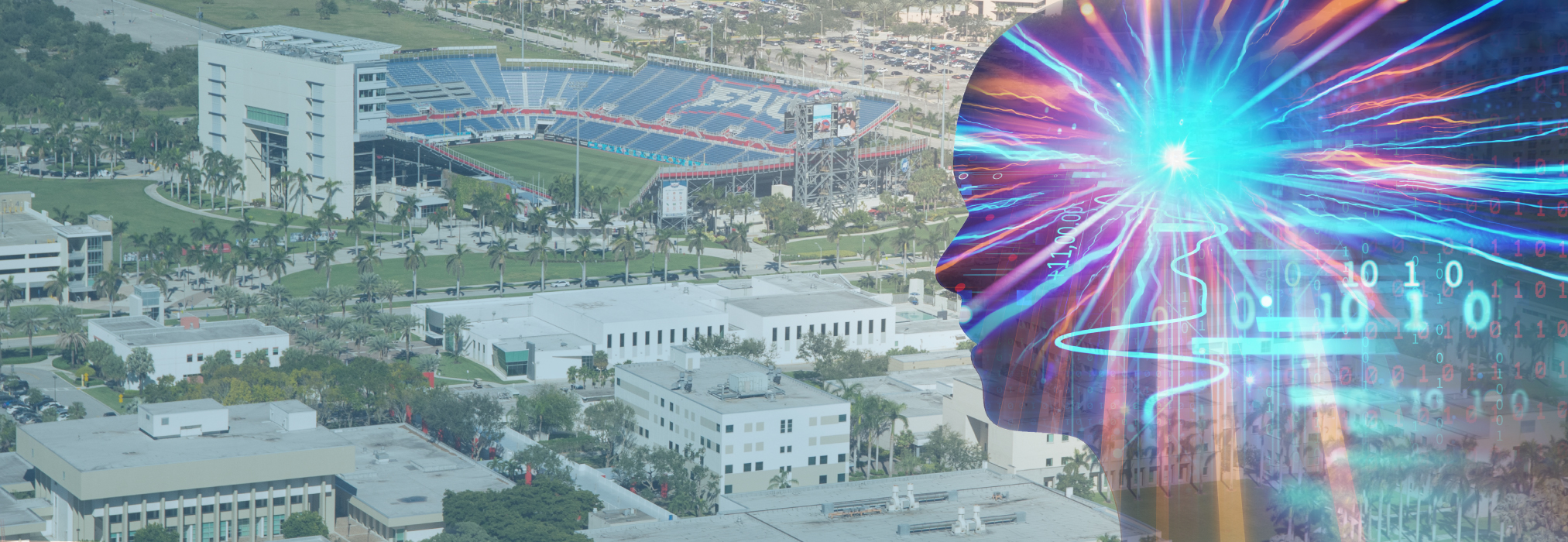Taking the Lead in AI Revolution
The world's next industrial revolution has begun, and it is being nurtured at FAU — which was recently named Florida's official "University of Distinction" for artificial intelligence and big data analytics.
Artificial intelligence (AI), the technology largely responsible for the next revolution, allows humans to hand off to smart machines an increasingly long list of tasks we think they can do better, more cheaply — or that simply wouldn't be possible otherwise. The potentially sweeping effects of AI and data science are sometimes compared to those brought on by the advent of electricity and the computer.
"AI is so pervasive that there is hardly any industry that is not affected by it or growing in that direction," said Stella Batalama, Ph.D., professor and dean of the College of Engineering and Computer Science. "This is a critical moment for FAU; the university is well positioned to become a leader in AI and related fields."
FAU already has significant expertise in place. Research at the Institute for Sensing and Embedded Network Systems Engineering (I-SENSE), for example, focuses on sensing the environment and interpreting that data with AI — the sort of technology that could enable self-driving cars to detect road conditions and navigate safely. Meanwhile, researchers in the College of Engineering and Science and across the university are developing and applying AI in many ways, even exploring its ethical implications.
The technology has captured students' imagination, said Jason Hallstrom, Ph.D., a professor in the college and director of I-SENSE. "Many come in and want to specialize in AI. They also see the chance to significantly increase their future pay scale."
The College of Engineering and Science is implementing new degree options for these students, including a Master of Science with a major in AI, the first such degree in the state; a multidisciplinary master's of science in data science and analytics; and a joint degree that funnels students from the Harriet L. Wilkes Honors College to a master's of science in data science. Compared to its inspiration, the human brain, state-of-the-art AI's capabilities are unlimited. The technology's greatest potential arises when used within autonomous machines that work together — like self-driving cars optimizing traffic flow, or a swarm of drones re-establishing a wireless network after a disaster. "One thousand of these machines with the ability to communicate and collaborate, that becomes extremely powerful," Hallstrom said.
Considered a test of intelligence, the game of chess once exemplified the goals of AI. By this metric, machines surpassed their creators in 1997, when IBM's Deep Blue beat the human world champion.
The concept of AI has since evolved beyond retrieving information and using formulas to solve complex problems. "The use of algorithms that mimic the interconnected neurons within the brain created a powerful new form of machine learning," said Xingquan "Hill" Zhu, Ph.D., a professor in the College of Engineering and Computer Science. Given data, learning AI can detect patterns and acquire insight available no other way. For example, one such system, capable of deep learning, recently taught itself the game of chess, instead of being told how to play. "Deep learning can be more powerful than human abilities for certain, narrow tasks," Zhu said. These algorithms excel, for example, at classifying images, like those recorded on video. However, they have yet to approach humans' broader, intuitive intelligence. In his own work, Zhu uses such AI to examine large sets of interconnected data — think of social media users linked by comments and "likes." Based on these connections, Zhu builds a map, or network, of the data and uses it to make inferences and predictions. He and colleagues, for example, built a network representing clinical trials involving infectious diseases, mapping the connections between thousands of researchers and diseases. He plans to use it to predict which trials will terminate early. In another project, he developed AI to analyze health records to anticipate which hospital patients will be readmitted. He also works on detecting changes in data, like temperature, collected continuously by sensors.
"The understanding of intelligence was once just reasoning, now it is much broader. AI is expected to have sensors to see and hear, to learn, even perform physical tasks," Zhu said. "Many years ago, AI used to be like the brain, now AI is like the brain and the body."
It wasn't HAL, the astronaut-killing computer from 2001: A Space Odyssey. Nor was it Skynet, the military superintelligence from the Terminator movies, that sparked Gerald Sim's concerns about AI. Rather, it was Netflix.
The streaming service collects massive amounts of data on its viewers, which AI then parses to offer recommendations to keep them enthralled. Learning this, Sim, Ph.D., an associate professor of media studies in the Dorothy F. Schmidt College of Arts and Letters, became interested in the ethical implications of the technology.
Recommendation systems are only one way AI has entered daily life; others include virtual assistants like Alexa, facial recognition and customer service chatbots. "This technology pervades our lives. It is not something you can opt out of easily," Sim said, noting that companies like Netflix, Amazon, Google and Facebook use AI to subtly modify their users' behavior. Although often presented as offering freedom, this technology limits choices, he said.
He has other reasons for concern: People tend to defer to a computer's decision because they perceive it as objective. Yet societal biases are often baked in; facial recognition software performs best for white men, for instance. And it's often impossible to know how AI has made a decision. Applications of the technology raise nuanced questions, he said. For instance, how will self-driving cars balance the potentially conflicting need to protect their drivers versus pedestrians? As Sim sees it, fantasies about smart, killer machines are a distraction from ethical issues like these raised by real AI.
"It's not about going back to the 1800s," Sim said. "It's really about setting up a more careful process of training, development and monetization, so we can really think through how the technology should be used."
Artificial intelligence mimics aspects of human intelligence, like learning. It is generated by giving computers step-by-step instructions known as algorithms. AI can take a digital form, like a chatbot, or engineers can combine it with robotics, sensors and wireless communication to create things like self-driving cars or package-delivering drones.
A powerful new computing resource, the Artificial Intelligence and Deep Learning lab at FAU, will serve as a hub for research and training.
Researchers from the College of Engineering and Computer Science, Charles E. Schmidt College of Medicine and FAU's Harbor Branch Oceanographic Institute, received a $652,820 grant from the National Science Foundation (NSF) to establish the first NSF-funded Major Research Instrumentation (MRI) Artificial Intelligence and Deep Learning (AIDL) Training and Research Laboratory in Florida. NSF's MRI program serves to increase access to multi-user scientific and engineering instrumentation for research and research training in institutions of higher education and not-for-profit scientific/engineering research organizations in the United States.
FAU's AIDL laboratory will be shared across multiple campuses and research disciplines and significantly advance FAU's role in AI and deep learning-based intelligent information analysis.
• 13 percent increase in computer-related occupations, including those involving AI, is expected between 2016 and 2026, twice the average growth rate for all trades. (U.S. Bureau of Labor Statistics)
• 1.8 million jobs are projected to be eliminated by 2020 due to AI, but AI will create 2.3 million new ones. (Gartner)
• $100,000 to $150,000 expected annual salary for AI programmers, and AI engineers more, with top earners above $250,000. (Datamation, 2018)
If you would like more information, please contact us at dorcommunications@fau.edu.
Implementing AI: Faculty from many fields are using the technology in innovative ways. Below are a few examples:

Dimitris Pados, Ph.D., develops new wireless technology that allows a team of machines to communicate dynamically with no human intervention, even in problematic places such as underwater. The machines sense their environments, determine the most effective means to communicate and adapt to challenges. Pados is a professor in the College of Engineering and Computer Science, Charles E. Schmidt Eminent Scholar in Engineering and I-SENSE fellow.

Taghi Khoshgoftaar, Ph.D., is applying AI capable of learning to a number of medicine-related problems. His projects include testing a new tool to assess cognitive impairment associated with Alzheimer's disease, predicting recovery time from sports-related concussions and identifying Medicare fraud. Khoshgoftaar is the Motorola professor in the College of Engineering and Computer Science.
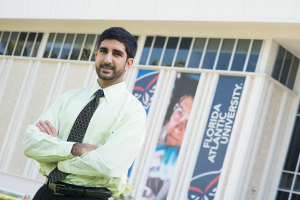
Sameer Hinduja, Ph.D., combines behavioral and computer science to better identify and control cyberbullying on social media. His work helps to inform the creation of better algorithms to identify harmful content and induce users to reconsider making hurtful posts. Hinduja is a professor in the School of Criminology and Criminal Justice in the College for Design and Social Inquiry, and co-director of the Cyberbullying Research Center.
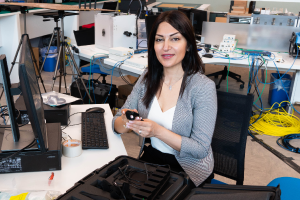
Behnaz Ghoraani, Ph.D., has combined an algorithm with wearable motion sensors to monitor Parkinson's Disease patients' response to medication. With this information, it is possible to better adjust treatment to account for the progression of the disease. Ghoraani is an assistant professor in the College of Engineering and Computer Science, and a fellow of I-SENSE and the Brain Institute.
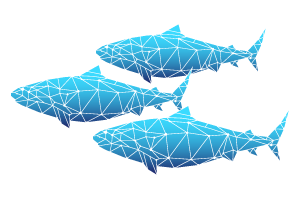
Siddhartha Verma, Dimitios Pados, Oscar Curet, Georgios Sklivanitis and Yufei Tang
Reinforcement learning for navigation and coordination of bioinspired underwater vehicles in close formation — a school of robotic fish. The aim is to investigate optimal control mechanisms for robots that use fin-based propulsion. The goal is to implement an autonomous controller that would allow the robotic swimmer to perform high-level tasks such as station-keeping, trajectory-following or performing collaborative tasks in groups, especially in the presence of external disturbances. The novel aspect of the ongoing work is the ability of the robotic swimmer (and eventually, of swarms) to make decisions completely autonomously in order to attain a specified high-level goal. The range of potential applications include: long-term environmental monitoring, deep water observation of aquatic animals, surveillance for coastal protection, and most-importantly, underwater search-and-rescue operations. The biggest benefit of using an autonomous controller is that individuals as well as swarms would be able to respond to unfamiliar situations and unexpected environmental disturbances. Autonomy is crucial since it may not be feasible for a human to monitor the robotic devices 24x7, or the time-delay in communication may be significant as is the case for underwater communication.
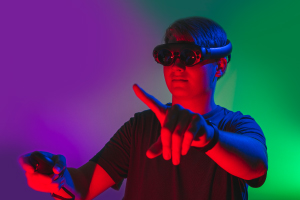
An FAU artificial intelligence (AI) initiative, backed by a $1 million donation from Rubin and Cindy Gruber, will open the Rubin and Cindy Gruber Sandbox, a 3,400 square-foot space on the ground floor of the main library at FAU that is being converted to a state-of-the-art artificial intelligence lab.
The Sandbox will be the first of its kind in the world: a working university AI lab that is open access, designed to engage students from across all academic disciplines and levels to learn about this transformative technology and apply it to their areas of study and passion, according to Elan Barenholtz, co-director of the Charles E. Schmidt College of Science's Machine Perception and Cognitive Robotics (MCPR) laboratory.
"We believe this will be the first such space in the nation to bring AI education and resources to all disciplines," Barenholtz said. "VR (virtual reality) and AR (augmented reality) are going to be transformative technologies across many disciplines and industries, but the vast majority of students have never directly experienced these technologies while an even smaller number have had a chance and to actively engage with them and develop with them."
Within the Sandbox, there will be a new lab called the Portal, which will serve as a collaborative space specifically focused on augmented reality (AR) and virtual reality (VR). Helping to bring innovative technology into the library, the Portal is equipped with Magic Leap One, HTC Vive Eye Pro, and Oculus Quest technology.
The Portal was opened in partnership with MCPR laboratory. MCPR is led by co-directors Barenholtz and William Edward Hahn and educates students from high school to doctoral studies in the cutting-edge techniques of artificial intelligence.
Carol Hixson, dean of University Libraries, said partnership with the MPCR Lab is a natural fit. "The Gruber Sandbox is a natural extension of the library's reimagining of spaces and services to meet the evolving needs of all FAU students," she said. "We are delighted to partner with the MPCR Lab to break down traditional disciplinary barriers and provide equitable access to this game-changing technology."
